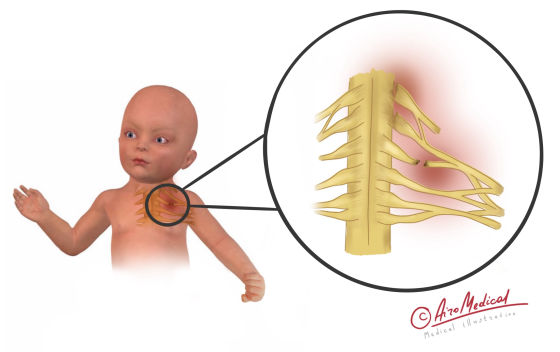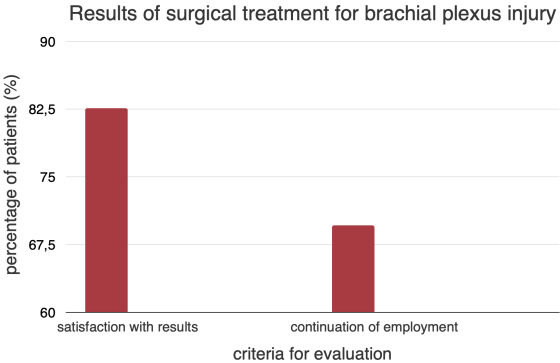Nerve root and plexus disorders
 What are the nerve root and plexus injuries?
What are the nerve root and plexus injuries?
Nerve, nerve root, and plexus diseases are common neurological conditions with typical symptoms. The disorders can affect a single nerve or a plexus of them. Nerve root disease causes pressure, pinching, or stretching of the nerve tissue that exits or enters the spinal cord. It is usually caused by bony growths on the vertebrae and narrowing of the opening through which the nerve passes, herniated disc or osteochondrosis.
 Typical nerve root lesions occur in the neck (cervical spine) and lower back (lumbar spine). For example, low back pain that radiates down the back of the thigh into the leg is sciatica. Likewise, neck pain radiates down the neck to the shoulder, and the arm is a nerve root disease.
Typical nerve root lesions occur in the neck (cervical spine) and lower back (lumbar spine). For example, low back pain that radiates down the back of the thigh into the leg is sciatica. Likewise, neck pain radiates down the neck to the shoulder, and the arm is a nerve root disease.
The plexus is a network of intersecting nerve fibres that control sensation and motor functions. It is like an electrical junction box that distributes wires to different house parts. Plexuses of nerves serve a specific part of the body and distribute nerve impulses. Nerve damage will cause problems in the region that those nerves innervate.
The most common plexus diseases affect the brachial plexus, which serves the chest, shoulders, arms, and hands; and the lumbosacral plexus, which serves the back, abdomen, groin, thighs, knees, and calves, as well as the pelvis, buttocks, genitals, thighs, calves, and feet.
 Diagnostic tests
Diagnostic tests
The most common causes of nerve root and plexus lesions are sports or car accident injuries and trauma at birth. Symptoms include severe pain, weakness, loss of sensation and/or loss of movement. Low back pain is a malfunction of the lumbosacral plexus. Other signs contain radiating pain, numbness, tingling, weakness, and shooting pain. Symptoms are the key to where the nerve is compressed.
The most common forms of diseases of the nerves, nerve roots and plexuses vary greatly in causes and manifestations:
- Carpal tunnel syndrome affects the wrist (median nerve);
- Cubital tunnel syndrome affects the forearm (ulnar nerve);
- A brachial plexus disorder affects the arms and hands;
- The disease of the lumbosacral plexus affects the back of the thigh, most of the lower leg and foot, and part of the pelvis;
- Syndrome of the thoracic outlet or upper aperture.
Diagnosis of the nerve root and plexus involvement will include a comprehensive medical examination shortly after injury or symptoms appear. A neurological exam usually includes:
- X-ray detects fractures or other damage to the bone and dense tissues around the nerve plexuses.
- A computed tomography scan uses a series of X-rays and a computer to make a three-dimensional nervous system image.
- Nerve conduction study and electromyogram - with the help of needle electrodes, the functions of the nerve and its activity are determined.
- Magnetic resonance imaging scan - creating a clear image inside the patient's body using a large magnet, radio waves and a computer.
All diagnosis is aimed at identifying the causes of pain.
 Treatment methods
Treatment methods
Treatment for a nerve root and plexus disorder depends on the cause. Minor injuries respond well to a combination of non-surgical treatments. These include:
- Physical therapy is a set of exercises that can help restore the function of a damaged organ and improve the range of motion and flexibility of stiff muscles and joints.
- Creams or injections of corticosteroids are a pain relief therapy during healing.
- Auxiliary devices include braces, splints, compression sleeves, etc.
- Medications to help manage pain.
- Occupational therapy - practising skills such as dressing and cooking in cases of severe muscle weakness, numbness and pain.
Depending on the cause of the damage to the nerve roots and plexuses and the severity of the trauma, surgery may be the only way to restore function. The attending physician may suggest the option of nerve decompression or neurolysis.
- Nerve decompression is based on the surgical release of tight fascia, muscles, tendons, and sometimes bones compressing the nerve. The goal is to provide space for the nerve. Timely execution of this operation leads to faster recovery of movements, sensations and functions.
- Neurolysis is another name or type of nerve decompression that explicitly cuts out the scar tissue around the nerve.
 New treatment options
New treatment options
Nervous tissue grows and heals slowly, so the results of operations can be seen from several months to several years. Therefore, the modern solution to the problem of nerve roots and plexus damage is aimed at minimally invasive intervention. Surgical methods can include:
- Nerve graft - the damaged part of the nerve is removed and replaced with a part of a healthy one taken from another part of the body. Or the removed component of the nerve from another part of the body connects the two ends of the torn nerve, thus accelerating the healing process.
- Nerve transfer – attachment of a less essential but still functional nerve to an injured nerve, creating the basis for new growth. For example, if a nerve root has been severed from the spinal cord, surgeons often take the nerve still working and connect it to the non-working nerve. It provides a bypass for new nerve growth.
- Tendon and muscle grafting – moving a tendon or muscle from one part of the body to another to restore function. Usually, a muscle or tendon is taken from the thigh and transferred to the arm. This way, the nerves and blood vessels that feed the muscle are connected.
 Statistics and prognosis
Statistics and prognosis
The shoulder joint is the most injury-prone in the human body, accounting for 45% of all injuries. With an incidence of up to 65% after a shoulder dislocation, nerve injury is often reported. In addition, brachial plexus injury occurs in 5 out of 1,000 newborns. And the number of brachial nerve damages among adults and adolescents is rising due to traffic accidents and sports injuries.
A 20-year follow-up at the Louisiana State University Health Sciences Center followed patients treated for a brachial plexus trauma. 82.6% of patients who underwent surgical treatment were satisfied with the operation result, and 81.2% answered positively about whether they would do the operation if they knew the current impact. Overall, 69.6% of patients continued their work after surgery.

If you or someone of your loved ones suffers from damage to the nerve roots and plexuses, contact AiroMedical, our specialists own the entire modern database and are experts in these diseases. We aim to help reduce your pain and restore body functions so you can return to the life you love.
References:
- Los Angeles Nerve Institute: Nerve Decompression/Neurolysis
- Springer Nature Switzerland AG: Nerve Root and Plexus Lesions
- Science Direct: Nerve Root Injury
- Brought to you by Merck & Co, Inc.: Peripheral Nerve and Related Disorders
- National Library of Medicine: Incidence, diagnostics and treatment algorithm of nerve lesions after traumatic shoulder dislocations: a retrospective multicenter study
- National Library of Medicine: Nerve transfer surgery for adult brachial plexus injury: a 10-year experience at Louisiana State University
- Christopher & Dana Reeve Foundation: Brachial plexus injury